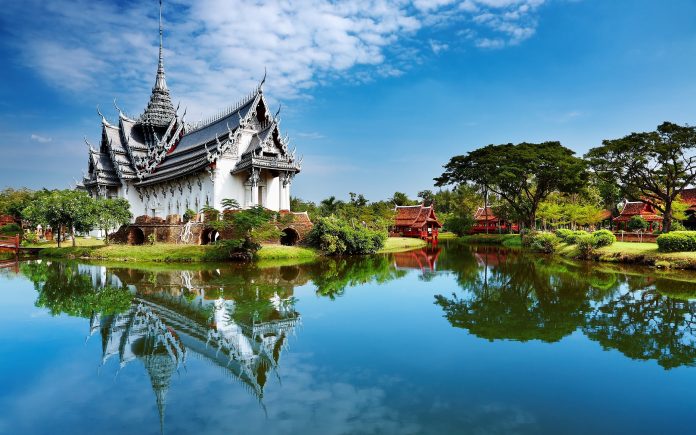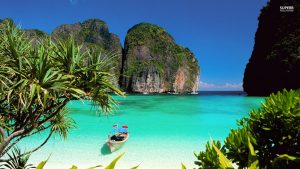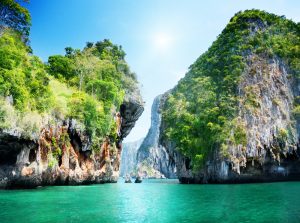History of Thailand – A constitutional monarchy occupying the center of Indochina, with seacoasts on the Gulf of Thailand and the Andaman Sea. Thailand ’s central position has led to continual conflict with neighboring Myanmar, Cambodia, and Vietnam as their contending empires sought control of the region.
Early Thailand was thinly settled and remained largely vacant for much of its history. Two Indian influenced cultures developed in the region; the Mons in lower Burma and central Thailand and the Khmers in the Mekong River valley. The stronger Khmer Empire displaced the Mons from all their territory except a small state of Haripunjaya in central Thailand and then found their own power and influence rapidly eroding. Beginning in the 13th century a.d., Thai settlers moved southward from China and established small states throughout Indochina. In Thailand two major states became established: Sukhothai and Chiang Mai. Sukhothai was founded after a successful revolt against a Khmer-controlled outpost c. 1220, and it ruled Thailand ’s central plain.
In the north, Chiang Mai was founded in 1296 after the defeat of Haripunjaya. In the early 15th century Sukhothai was absorbed by the emerging kingdom of Ayutthaya.
Ayutthaya differed from Sukhothai in its effective use of centralized power through an organized and efficient governmental bureaucracy. The Thai state prospered and traded with China, Vietnam, India, Java, and Malacca while conducting continual wars of expansion. Ayutthayan expansion in the 14th century encroached on Kampuchean territory, and by the 15th century an often contested but durable link of vassalage held Kampuchea under Thai domination.
The Ayutthaya kings tried repeatedly to dominate the northern Thai kingdoms of Chiang Mai and Laos but never succeeded.
The only major threat to Ayutthayan dominance emanated from Burma. In the 16th century Burmese troops briefly succeeded in reducing Siam to vassalage.
During the 17th century European trading and religious influences began to affect Siam. The Dutch established an early stranglehold on trade, and the Thais welcomed missionaries from France as a counterbalance.
When the French used this welcome to establish a large armed mission in 1687, Thai mistrust led to an anti-Western coup that served to keep Siam aloof from further Western contact for the next 150 years.
In 1767 a second Burmese invasion broke the Ayutthayan state by sacking the capital city of Ayutthaya.
A noble named Taksin succeeded in routing the Burmese and set up a new capital at Thon Buri.
In 1781 he was deposed after losing his mind, and Siam’s leading general, Chao Phraya Chakkri, assumed the throne and founded the royal Chakkri dynasty that still heads the country. He immediately moved the capital across the Chao Phraya River to Bangkok, and he and his successors proceeded to restore Siam’s power over its vassal states, including Kampuchea, the Malay Peninsula, and the Lao kingdom of Wiangchan (Vientiane).
Most of Siam’s trade was with China, and an enormous surge of Chinese immigration to Bangkok found the city half Chinese by the middle of the 19th century. The Chinese brought advanced commercial acumen to Siam, and Western countries demand ed an end to the century-and -a-half of isolation. During the 1850s the kingdom granted both free trade and consular representation to leading Western powers. King Mongkut (1851–68) and his son Chulalongkorn (1868–1910) saw little hope of resisting increasing Western demand s for concessions and grudgingly gave up Kampuchea and Laos to France and Malaysia to Great Britain. Internally Siam’s monarchy successfully worked to reform and strengthen their government on a Western model, better to retain their independence.
In World War I Siam fought on the Allied side and in return received favorable treaty provisions. In 1932 a coup established a constitutional government, ending absolute monarchy in the country. Thailand allied itself with Japan in World War II, and since then the nation has been dominated by military leadership, under the influence of the United States, interspersed with brief interludes of civilian rule. Since the Vietnam War the country has moved steadily toward democracy. Thailand resumed civilian rule in 1975, but it saw a military coup in 1976. Several military premiers followed.
In 1992, after anti-government demonstrators were killed, King Bhumibol Adulyadej appointed a civilian as interim prime minister. In the 1992 elections, anti-military parties won a majority, and Chuan Leekpai became prime minister of a coalition government.
In 1995 the parliament approved constitutional reforms, lowering the voting age to 18, guaranteeing equal rights for women, and reducing membership in the military-dominated senate. In 1995 Chuan’s government fell because of a land -reform scand al. New elections brought the Chart Thai Party to power with Banharn Silpa-archa as prime minister, heading a seven-party coalition. The coalition soon fell apart, and in 1997, Chuan again became prime minister and a new constitution was approved.
Thailand enjoyed an economic boom in the 1990s, but in 1997 there was a monetary crisis in Southeast Asia, and Thailand became mired in a deep recession. The International Monetary Fund pledged to provide Thailand with a $17 billion loan, and by 2000 the economy recovered somewhat. In 2001, the Thai Rak Thai formed a coalition government with Thaksin Shinawatra as prime minister. In 2004 there were attacks by Muslim separatists in Thailand ’s three southern provinces. Relations in the southern provinces improved, however, when the government provided strong aid to the region after the Indian Ocean tsunami in December of 2004. Some 5,300 people died there, many of them foreign tourists.








